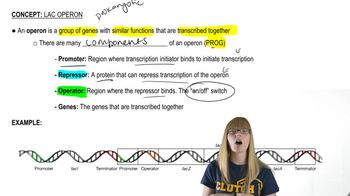Table of contents
- 1. Introduction to Genetics51m
- 2. Mendel's Laws of Inheritance3h 37m
- 3. Extensions to Mendelian Inheritance2h 41m
- 4. Genetic Mapping and Linkage2h 28m
- 5. Genetics of Bacteria and Viruses1h 21m
- 6. Chromosomal Variation1h 48m
- 7. DNA and Chromosome Structure56m
- 8. DNA Replication1h 10m
- 9. Mitosis and Meiosis1h 34m
- 10. Transcription1h 0m
- 11. Translation58m
- 12. Gene Regulation in Prokaryotes1h 19m
- 13. Gene Regulation in Eukaryotes44m
- 14. Genetic Control of Development44m
- 15. Genomes and Genomics1h 50m
- 16. Transposable Elements47m
- 17. Mutation, Repair, and Recombination1h 6m
- 18. Molecular Genetic Tools19m
- 19. Cancer Genetics29m
- 20. Quantitative Genetics1h 26m
- 21. Population Genetics50m
- 22. Evolutionary Genetics29m
13. Gene Regulation in Eukaryotes
GAL Regulation
Problem 9
Textbook Question
Compare and contrast the transcriptional regulation of GAL genes in yeast with that of the lac genes in bacteria.
 Verified step by step guidance
Verified step by step guidance1
Step 1: Understand the basic components involved in the transcriptional regulation of GAL genes in yeast. The GAL genes are regulated by the presence of galactose and involve key proteins such as Gal4, Gal80, and Gal3.
Step 2: Examine the mechanism of transcriptional activation in yeast. Gal4 is a transcriptional activator that binds to upstream activating sequences (UAS) near the GAL genes. In the absence of galactose, Gal80 binds to Gal4, inhibiting its activity. When galactose is present, Gal3 binds to Gal80, causing a conformational change that releases Gal4, allowing transcription to proceed.
Step 3: Explore the components involved in the transcriptional regulation of the lac operon in bacteria. The lac operon is regulated by the presence of lactose and involves the lac repressor and the catabolite activator protein (CAP).
Step 4: Analyze the mechanism of transcriptional regulation in bacteria. In the absence of lactose, the lac repressor binds to the operator region, preventing transcription. When lactose is present, it is converted to allolactose, which binds to the repressor, causing it to release from the operator, allowing transcription. Additionally, when glucose levels are low, cAMP levels increase, allowing CAP to bind to the promoter and enhance transcription.
Step 5: Compare and contrast the two systems. Both systems involve regulatory proteins that respond to the presence of specific sugars, but they differ in their mechanisms and components. Yeast uses a complex of proteins to regulate transcription, while bacteria use a repressor-operator system and an additional layer of regulation through CAP in response to glucose levels.
Recommended similar problem, with video answer:
 Verified Solution
Verified SolutionThis video solution was recommended by our tutors as helpful for the problem above
Video duration:
2mPlay a video:
Was this helpful?
Key Concepts
Here are the essential concepts you must grasp in order to answer the question correctly.
Transcriptional Regulation
Transcriptional regulation refers to the mechanisms that control the transcription of genes, determining when and how much of a gene product is produced. In both yeast and bacteria, this regulation is crucial for responding to environmental changes and metabolic needs. It involves various proteins, such as transcription factors, that bind to specific DNA sequences to enhance or inhibit gene expression.
Recommended video:
Guided course

Eukaryotic Transcription
GAL Genes in Yeast
The GAL genes in yeast (Saccharomyces cerevisiae) are involved in the metabolism of galactose. Their expression is regulated by the presence of galactose and the absence of glucose, utilizing a complex system involving the GAL4 transcription factor, which activates the transcription of these genes when galactose is available. This regulation exemplifies eukaryotic gene control, which often involves chromatin remodeling and multiple regulatory elements.
Recommended video:
Guided course

GAL Regulation
Lac Operon in Bacteria
The lac operon in bacteria, particularly in Escherichia coli, is a well-studied model of gene regulation that controls the metabolism of lactose. It consists of structural genes (lacZ, lacY, lacA) and is regulated by the presence of lactose and glucose. When lactose is present, it binds to the repressor protein, allowing transcription to occur, demonstrating a classic example of negative regulation in prokaryotes.
Recommended video:
Guided course

Lac Operon Overview

 3:55m
3:55mWatch next
Master GAL Regulation with a bite sized video explanation from Kylia Goodner
Start learningRelated Videos
Related Practice

